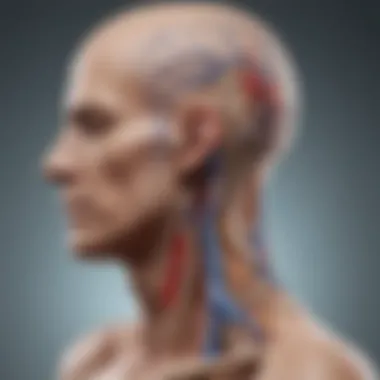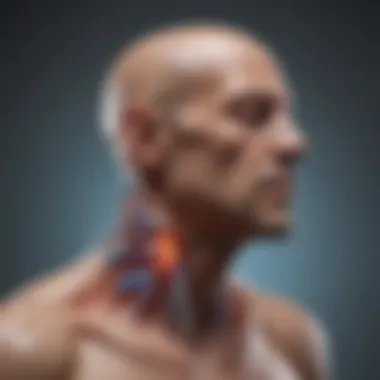Migraines and Neck Stiffness: Understanding the Link


Intro
Migraines and neck stiffness are two common conditions that often occur together. The relationship between these two can be complex. Understanding this connection is essential for effective management. Many patients experience neck stiffness, which may precede or accompany migraine attacks. This correlation raises questions about underlying mechanisms and treatment implications. Practitioners and researchers alike seek to unlock insights into how dysfunction in the cervical spine relates to migraines. This article explores the intricate ties between these conditions, highlighting important concepts, current research trends, and clinical considerations.
Key Concepts
Definition of the Main Idea
Migraines are characterized by intense, throbbing pain, often accompanied by nausea and sensitivity to light and sound. Neck stiffness, on the other hand, commonly refers to a rigidity or discomfort in the neck area. Both can significantly impact a person's quality of life. What is particularly intriguing is the interplay between the two conditions. Some research suggests that neck stiffness may influence the frequency and severity of migraine attacks. Understanding this relationship could improve diagnostic and treatment strategies.
Overview of Scientific Principles
The cervical spine plays a vital role in the overall function of the neck. Dysfunction in this area can lead to inflammation and irritation of the surrounding structures. This, in turn, may impact neural pathways involved in pain perception. Researchers believe that inflammatory processes in the cervical region may sensitize the trigeminal nerve, a key player in migraine attacks.
Moreover, muscle tension in the neck can trigger pain signals that overlap with migraine pain, suggesting a possible feedback loop.
"Chronic neck tension could be considered a factor in both the initiation and maintenance of migraines."
"Chronic neck tension could be considered a factor in both the initiation and maintenance of migraines."
Current Research Trends
Recent Studies and Findings
Recent studies have aimed to elucidate the connection between cervical dysfunction and migraines. One significant study published in 2022 found that individuals with chronic migraines often reported higher instances of neck pain and stiffness. Treatments targeting cervical spine issues led to notable improvements in migraine frequency and intensity.
Another research effort examined the impact of physical therapy on patients with both conditions. Results indicated that patients who engaged in targeted neck exercises experienced reduced migraine severity.
Significant Breakthroughs in the Field
One breakthrough in this field is the growing recognition of the importance of a multidisciplinary approach. Combining chiropractic care, physical therapy, and medication offers a more comprehensive treatment plan. Studies indicate that integrated care can address both cervical dysfunction and migraine symptoms effectively.
Additionally, advancements in imaging techniques provide better insight into cervical spine health. This enhanced understanding allows practitioners to tailor interventions to individual patient needs, making it easier to address both migraines and neck stiffness simultaneously.
Prologue to Migraines and Neck Stiffness
Migraine and neck stiffness present a prevalent yet often overlooked relationship that merits deeper exploration. This section aims to provide context and underscore the significance of connecting these two common conditions. As many individuals face the dual challenge of managing migraines alongside neck stiffness, understanding their interrelation can lead to better treatment outcomes and improved quality of life.
The complexity of this topic arises from the overlap in symptoms and underlying mechanisms. Migraines, characterized by intense headaches, can often accompany neck stiffness due to various physical and physiological reasons. Conversely, neck stiffness may also predispose individuals to experience more frequent or severe migraine attacks.
Considering this link is essential for healthcare practitioners and patients alike. Identifying and addressing neck stiffness might alleviate the frequency or intensity of migraines for those affected. This understanding not only aids in effective diagnosis but also facilitates targeted treatment strategies.
As we delve further into the nuances of migraine symptoms and the potential contributing factors associated with neck stiffness, the benefits of recognizing this relationship will become increasingly clear. The insights gained here aim to enrich the diagnostic and therapeutic approaches available to both professionals and individuals suffering from these co-occurring conditions.
Defining Migraines
Migraines are a prevalent yet complex neurological condition that affects millions worldwide. Understanding migraines is crucial in comprehending their relationship to neck stiffness. By defining migraines, we can analyze how factors associated with migraines may contribute to symptoms like neck stiffness. This section addresses critical characteristics of migraines while emphasizing their impact on daily life and overall health.
Clinical Symptoms of Migraines
Migraines present with a range of clinical symptoms that go beyond mere headaches. The most common symptom is a pulsating headache, typically localized to one side of the head. Accompanying symptoms often include nausea, vomiting, and heightened sensitivity to light and sound.
The duration of a migraine attack can vary, lasting anywhere from a few hours to several days. Importantly, understanding these symptoms is vital for accurate diagnosis and effective management. Poorly managed migraines can lead to significant disruption in one’s lifestyle and productivity, which may exacerbate any concurrent conditions like neck stiffness.
Types of Migraines
Migraines can be classified into several types. Each type reflects different characteristics, triggers, and underlying mechanisms. Three prominent types are chronic migraines, triggering factors, and aura versus non-aura migraines.
Chronic Migraines


Chronic migraines are defined by the frequency of episodes, occurring 15 or more days a month for at least three months. This specific aspect is important as it highlights the chronic nature of some individuals’ experiences with migraines. Chronic migraines can lead to a cycle of ongoing pain, impacting mental and physical well-being significantly.
The key characteristic of chronic migraines is their recurrence, which can become debilitating over time. Identifying chronic migraines plays a critical role in preventive strategies, making it an essential focus for this article.
Triggering Factors
Triggering factors are diverse and can vary widely among individuals. Common triggers include certain foods, stress, hormonal changes, and environmental factors such as bright lights or strong smells. The breadth of these triggering factors can help pinpoint potential links to neck stiffness.
Understanding these triggers is beneficial as it allows for tailored lifestyle changes to reduce the frequency of migraines. Recognizing that alleviating stress or improving posture might help in mitigating both neck stiffness and migraines enhances the practical value of the discussion.
Aura and Non-Aura Migraines
Aura and non-aura migraines represent another distinction in migraine types. Aura refers to neurological symptoms that precede or accompany the headache phase, such as visual disturbances or sensory changes. Non-aura migraines, in contrast, do not involve these warning signs.
The unique feature of aura migraines is their complex presentation, which can provide insights into the underlying mechanisms of the migraine itself. This characteristic is essential in an article discussing migraines and neck stiffness, as understanding the full spectrum of migraine experiences adds depth to potential management strategies.
In summary, defining migraines involves recognizing their clinical symptoms and types, each with unique characteristics and implications for individuals. This understanding not only enhances our knowledge of migraines itself, but also how they may relate to neck stiffness, thus providing a foundation for further exploration.
Understanding Neck Stiffness
In the context of this article, understanding neck stiffness is crucial due to its potential correlation with migraine episodes. Specifically, stiffness in the neck can impede spinal alignment and functioning, leading to heightened pain levels. Recognizing the mechanisms behind neck stiffness provides insight into how it can exacerbate migraine symptoms. By focusing on the specific causes and effects of neck stiffness, readers can better appreciate its importance in relation to migraines, potentially aiding both diagnosis and treatment.
Causes of Neck Stiffness
Neck stiffness can arise from several distinct issues, each contributing to the overall picture of discomfort that may overlap with migraines.
Muscular Strain
Muscular strain is a leading cause of neck stiffness and results from overuse or excessive tension in the neck muscles. This strain might stem from various activities, such as poor ergonomics during work or intense physical exertion. Importantly, muscular strain often manifests as localized pain and reduced range of motion, which can be particularly frustrating for individuals already experiencing migraines. The key characteristic of muscular strain is its painfulness, which can lead to a vicious cycle where increased tension can trigger a migraine. Thus, understanding it as a factor in this article is beneficial. Its advantage lies in the fact that many cases can be improved with simple adjustments, such as proper stretching and posture correction.
Degenerative Disc Disease
Degenerative disc disease involves the gradual deterioration of intervertebral discs in the cervical spine. This condition can cause stiffness and pain, resulting from age-related wear and tear. The pressing disadvantage of degenerative disc disease is that it can lead to chronic discomfort, influencing additional conditions such as migraines. The key characteristic here is the impact on mobility; as the discs degrade, they may pinch nearby nerves, exacerbating pain signals in the area. This aspect makes understanding this condition essential, as it opens avenues for managing not just neck stiffness but also related migraine episodes.
Posture-Related Issues
Posture-related issues are often underestimated contributors to neck stiffness. Poor posture can lead to overloading certain muscle groups in the neck, culminating in stiffness and pain. It’s characterized by habits like slouching or craning the neck forward while using devices, often leading to muscle fatigue. Addressing posture-related issues is beneficial in this article because changing habits can alleviate both neck stiffness and reduce the frequency of migraines. Moreover, teaching good posture practices can empower patients to take control of their conditions, thus improving their overall health.
Symptoms and Diagnosis
Symptoms of neck stiffness typically include difficulty moving the neck, muscle tightness, and sometimes radiating pain into the shoulders and upper back. Diagnosing neck stiffness often involves a physical examination, including assessing range of motion and tenderness in the muscles. In some cases, imaging studies like X-rays or MRIs may be warranted if underlying pathologies are suspected. Recognizing these signs is crucial, as they can lead to more effective interventions for managing both migraines and neck stiffness. It's important for healthcare professionals to remain vigilant and factor neck stiffness into their assessments of patients presenting with migraine symptoms.
The Connection Between Migraines and Neck Stiffness
Understanding the connection between migraines and neck stiffness is essential for those affected by these conditions. Many individuals who experience chronic migraines also report neck stiffness, which can complicate both diagnosis and treatment. A direct link between these two issues suggests that addressing one could positively influence the other. This relationship can provide valuable insights into effective management strategies, allowing healthcare professionals to tailor treatments for improved outcomes.
Anatomical Considerations
The cervical spine consists of seven vertebrae which support the neck and head. Muscles, ligaments, and nerves surround these vertebrae, creating a complex structure. The upper cervical area, particularly C1 and C2, plays a significant role in headaches and migraines. When neck stiffness occurs, it can lead to restricted movement in these vertebrae, potentially triggering migraines. The anatomy of the neck, including musculature and connective tissues, also impacts blood flow to the brain. Thus, a higher tension in neck muscles may lead to reduced blood circulation, further compounding migraine symptoms.
Neurological Pathways
Migraines are deeply routed in the nervous system, predominantly involving the trigeminal nerve. This pathway can be affected by neck stiffness. When the neck muscles are tense, they may irritate nearby nerves and tissues, sending signals to the brain that can trigger migraine attacks. Additionally, the cervical spine houses various nerve roots that communicate between the neck and head. Dysfunction in this area can lead to altered neural communication, which may increase perceived pain levels. Understanding these pathways is crucial; it helps researchers and medical professionals identify potential interventions in treating co-occurring neck pain and migraines.
Inflammatory Responses
Both migraines and neck stiffness can induce inflammatory responses in the body. Migraines, in particular, have an inflammatory component that may contribute to their onset. These responses can elevate pain sensitivity and exacerbate discomfort in individuals with neck stiffness. A tight neck muscle may release inflammatory mediators that travel through the surrounding tissues, influencing the pain perception in the head. Addressing inflammation through non-pharmacological or pharmacological treatments may offer relief for individuals dealing with both migraines and neck stiffness.
"The intersection of migraines and neck stiffness is more than just a coincidence. It can be viewed as a gateway for effective treatment strategies that account for their overlapping nature."


"The intersection of migraines and neck stiffness is more than just a coincidence. It can be viewed as a gateway for effective treatment strategies that account for their overlapping nature."
Recognizing the connection between migraines and neck stiffness is vital. This knowledge fosters a deeper understanding of pain management and treatment efficacy in a patient’s care plan.
Research Insights on Migraines and Neck Stiffness
Understanding the relationship between migraines and neck stiffness is essential for effective management and treatment. Research in this area can provide valuable insights into how these conditions interact. Investigating clinical studies and epidemiological data enhances our awareness of the mechanisms at play. These insights are crucial for being able to develop targeted strategies for relief, not only for patients who suffer from these conditions but also for healthcare professionals offering support.
Research has shown that migraines often co-occur with neck stiffness, suggesting that one may exacerbate the other. Identifying this link can lead to more comprehensive treatment plans. For example, improving cervical spine function may help reduce the frequency and severity of migraines.
Clinical Studies on Co-Occurrence
Clinical studies examining the co-occurrence of migraines and neck stiffness reveal striking patterns. Many studies indicate a high prevalence of neck stiffness among migraine patients. A significant percentage of participants report experiencing neck discomfort during migraine episodes.
- Study Findings:
- One study noted that nearly 70% of migraine sufferers also reported neck stiffness.
- Another revealed that treating neck stiffness can lead to a decrease in migraine frequency.
These findings suggest that the two conditions may share common underlying pathophysiological mechanisms. Treatment approaches that address both symptoms could enhance overall outcomes.
Healthcare professionals should consider these connections when developing treatment plans for patients with migraines. Integrating therapies that target neck stiffness may reduce migraine severity and frequency.
Epidemiological Data
Epidemiological data contributes significantly to our understanding of the relationship between migraines and neck stiffness. Population-based studies provide insight into how these conditions manifest across various demographics.
- Key Insights:
- Research shows that individuals with migraines often have a higher incidence of chronic neck pain compared to the general population.
- Women are more likely to experience both migraines and neck issues, possibly due to hormonal factors that influence muscle tension or pain perception.
- Studies indicate that lifestyle factors, such as poor posture and sedentary behavior, can further exacerbate both conditions.
Understanding these demographic trends can guide healthcare practitioners in identifying at-risk populations and tailoring prevention strategies. By analyzing epidemiological trends, we can build a more nuanced understanding of why these conditions often coexist.
Ultimately, expanding the research base in this area is crucial. Further clinical trials and longitudinal studies are needed to establish causation, develop effective interventions, and improve patient outcomes.
Management Strategies for Migraines and Neck Stiffness
Effective management of migraines and neck stiffness is crucial for improving the quality of life for those affected. Understanding various management strategies can provide valuable insights for medical practitioners and patients alike. This section highlights specific elements, benefits, and considerations about these strategies.
Non-Pharmacological Approaches
Non-pharmacological methods often serve as foundational treatments for addressing both migraines and neck stiffness. These approaches focus on lifestyle changes and physical interventions that can alleviate symptoms without relying solely on medication.
Physical Therapy
Physical therapy plays an essential role in managing neck stiffness, which can frequently coincide with migraine patterns. One specific aspect of physical therapy is the targeted exercises designed to strengthen cervical musculature. This is a beneficial choice for those suffering as it not only addresses muscle tension but also improves flexibility. Physical therapists may employ techniques like manual therapy or modalities such as heat or ice application.
A unique feature of physical therapy is its personalized approach, tailoring interventions to each individual’s needs. However, it may require several sessions before noticeable benefits are experienced.
Exercise and Stretching
Regular exercise and stretching can significantly impact neck stiffness and the frequency of migraines. A specific aspect is the incorporation of gentle stretching routines, which can enhance blood flow and promote relaxation. This approach is beneficial as it can be easily integrated into daily routines. The unique feature of this strategy is that it empowers individuals to take control of their symptoms with minimal resources. On the downside, it requires discipline and consistency to be effective.
Posture Improvement Techniques
Posture improvement techniques are vital because poor posture can lead to neck stiffness, exacerbating migraines. Emphasizing ergonomics in daily activities is a key characteristic of these techniques. This is beneficial as it may prevent the onset of symptoms before they arise. A unique aspect is the use of tools, like ergonomic chairs or stands, to promote correct posture. However, adapting to new habits may take time, posing a challenge for individuals.
Pharmacological Treatments
When non-pharmacological approaches are insufficient, pharmacological treatments can provide necessary relief. These medications play different roles, from addressing acute pain to preventing future episodes.
Analgesics


Analgesics are widely utilized for the immediate relief of migraine pain. One specific aspect is their effectiveness in promptly reducing headache intensity. This makes them a popular choice, particularly over-the-counter options like ibuprofen and acetaminophen. Their unique feature is their ability to provide rapid relief; however, overuse can lead to rebound headaches, making it essential to follow recommended guidelines.
Preventive Medications
Preventive medications are crucial for those with chronic migraines or persistent neck stiffness. A specific aspect is their role in reducing the frequency and severity of attacks. Medications like amitriptyline or beta-blockers are often prescribed. These options are beneficial for individuals at risk of frequent migraines. Their unique feature is long-term effectiveness, but individuals may experience side effects that need monitoring.
Muscle Relaxants
Muscle relaxants can be advantageous, especially when neck stiffness contributes to migraine patterns. They work by reducing muscle tension and pain. A key characteristic is their use in acute situations, often prescribed alongside other treatments. This option is beneficial for immediate relief; however, reliance on muscle relaxants can lead to dependency or sedation, necessitating careful management by healthcare providers.
By integrating non-pharmacological and pharmacological strategies thoughtfully, patients and healthcare providers can enhance management of migraines and neck stiffness effectively.
Role of Healthcare Professionals
The intersection of migraines and neck stiffness presents complex clinical challenges that necessitate a coordinated approach from healthcare professionals. A comprehensive understanding of the relationship between these conditions is crucial for effective patient management. Interdisciplinary collaboration among specialists such as neurologists, physiotherapists, and primary care providers can significantly enhance diagnostic accuracy and treatment efficacy.
One of the key benefits of an interdisciplinary approach is the ability to address the multifaceted nature of these conditions. Migraines can originate from various triggers, including cervical dysfunction, thus requiring input from professionals with diverse expertise. By sharing insights and expertise, healthcare professionals can develop more nuanced treatment plans tailored to individual patient needs. This enhances the likelihood of successful outcome by ensuring all potential contributing factors are addressed.
Moreover, healthcare providers play a pivotal role in diagnosis, ensuring that patients receive appropriate imaging and assessments to determine the root causes of their symptoms. This definitive diagnosis lays the groundwork for effective treatment strategies and paves the way toward improved quality of life for patients.
In addition to clinical management, participant education is a critical aspect of healthcare provided in the context of migraines and neck stiffness. Patients equipped with knowledge about their conditions are better positioned to manage their symptoms and seek timely help when necessary. This aspect of care not only empowers patients but also fosters improved healthcare outcomes.
Interdisciplinary Collaboration
Effective management of the relationship between migraines and neck stiffness cannot be achieved in isolation. Interdisciplinary collaboration is essential for creating a comprehensive approach to treatment. For instance, a neurologist might provide insight into the neurological aspects of migraines while a physical therapist can address the musculoskeletal factors related to neck stiffness. When specialists work together, they can design a cohesive treatment plan that considers both aspects of a patient's health.
The integration of various treatment modalities showcases the strength of collaborative practices. Evidence-based interventions, such as combining physical therapy with pharmacological treatments, often yield better results than unilateral approaches. Utilizing strategies from different disciplines also encourages innovation in treatment protocols, allowing for adjustments tailored to individual responses.
Patients benefit immensely from these collaborative efforts. They experience continuity in care and reduced occurrence of fragmented treatment plans that can lead to confusion. Furthermore, collaboration facilitates better communication with patients, ensuring they understand the rationale behind therapeutic choices and the importance of adhering to prescribed interventions.
Patient Education and Self-Management
Education is a powerful tool in managing both migraines and neck stiffness. Healthcare professionals should prioritize empowering patients to understand their conditions. This can include explanations of how neck stiffness may contribute to migraines, highlighting the importance of posture and ergonomics, and teaching self-management techniques.
Patient education often involves providing practical strategies for managing symptoms effectively. Patients can learn various techniques, such as:
- Stretching exercises: Simple routines can alleviate tension in the neck and reduce the frequency of migraine attacks.
- Heat therapy: Applying heat to stiff areas can promote relaxation of muscles, contributing to overall discomfort reduction.
- Lifestyle modifications: Emphasizing the significance of maintaining a healthy diet, staying hydrated, and identifying personal triggers can empower individuals to take control over their health.
Supportive resources should be shared, including guides for ergonomic workspaces, advice on proper sleeping positions, and even meditation techniques for stress reduction.
Here’s what effective patient self-management requires:
- Understanding triggers: Identifying food, environmental factors, or even stressors that lead to migraines can help patients avoid these triggers.
- Seeking timely help: Educating patients to recognize the signs of a worsening condition or an impending migraine can lead to quicker intervention and better outcomes.
Healthcare professionals must facilitate this learning process, helping patients become proactive participants in their healthcare. This collaboration between patients and providers can ultimately lead to enhanced treatment adherence and better management of migraines and neck stiffness.
Finale
The discussion surrounding migraines and neck stiffness is pivotal in understanding how these two conditions are interrelated. This article highlighted the complex mechanisms at play, revealing critical links that practitioners and patients must consider. Recognizing co-occurrence is essential because it influences treatment strategies and patient outcomes.
Importance of Understanding the Connection
- Clinical Perspective: Healthcare providers must be vigilant in identifying symptoms of both conditions, as neck stiffness may contribute to the frequency and intensity of migraines. Awareness enhances patient care and can lead to more accurate diagnoses.
- Patient Awareness: Educating patients about this link empowers them to recognize patterns and seek appropriate interventions. Self-management strategies can be more effective when individuals understand how neck stiffness might exacerbate their migraines.
Key Recommendations
- Maintaining proper posture can alleviate neck stiffness, which might, in turn, reduce migraine frequency.
- Incorporating therapeutic exercises focused on neck flexibility could provide added relief.
- Regular check-ups with healthcare professionals ensure ongoing assessment and adjustment of treatment plans.
In essence, the culmination of the information presented in this article illustrates that the relationship between migraines and neck stiffness is not merely an anecdotal observation but a clinically significant correlation. By deepening our understanding, we can facilitate better management strategies, leading to improved quality of life for many.
"Awareness of the links between migraines and neck stiffness can transform treatment paths, leading to more integrated care strategies."
"Awareness of the links between migraines and neck stiffness can transform treatment paths, leading to more integrated care strategies."
Through interdisciplinary collaboration and continuous patient education, the goal of reducing the burden of these conditions becomes more achievable.







